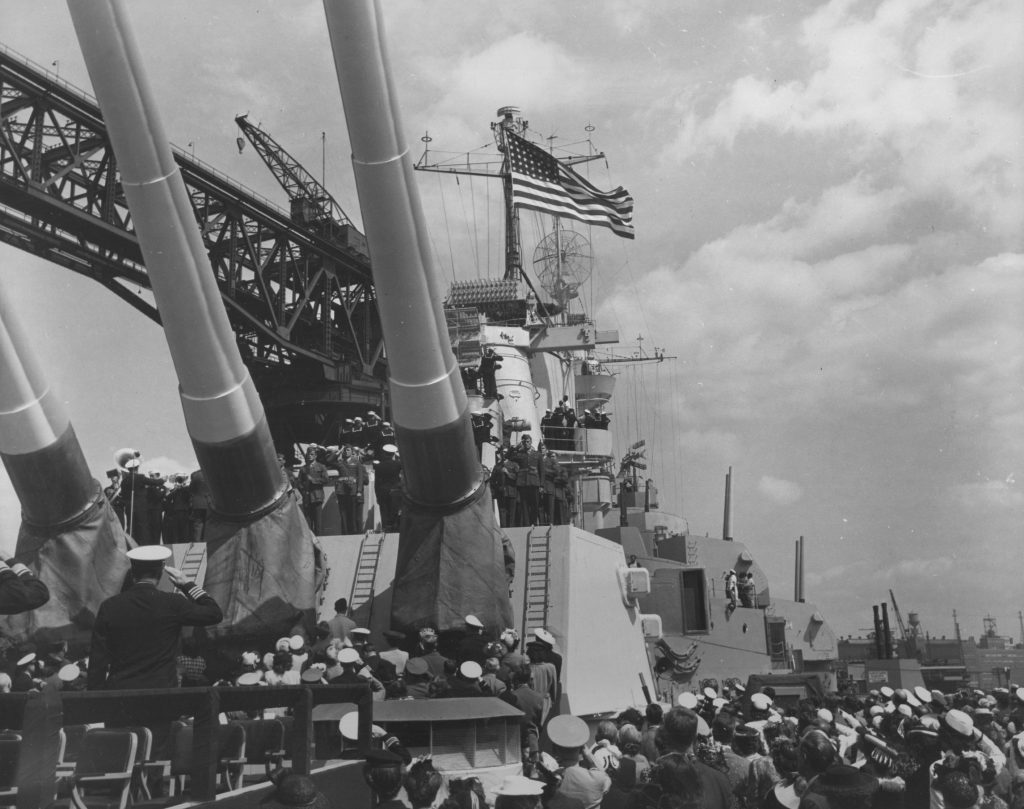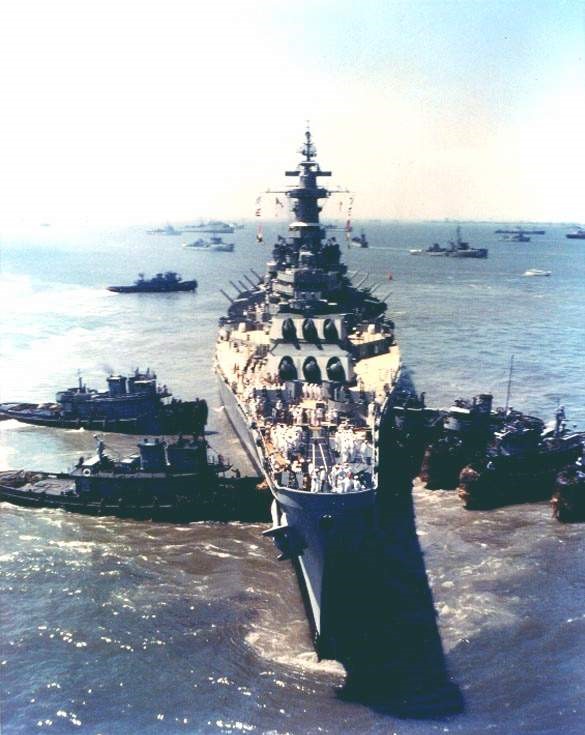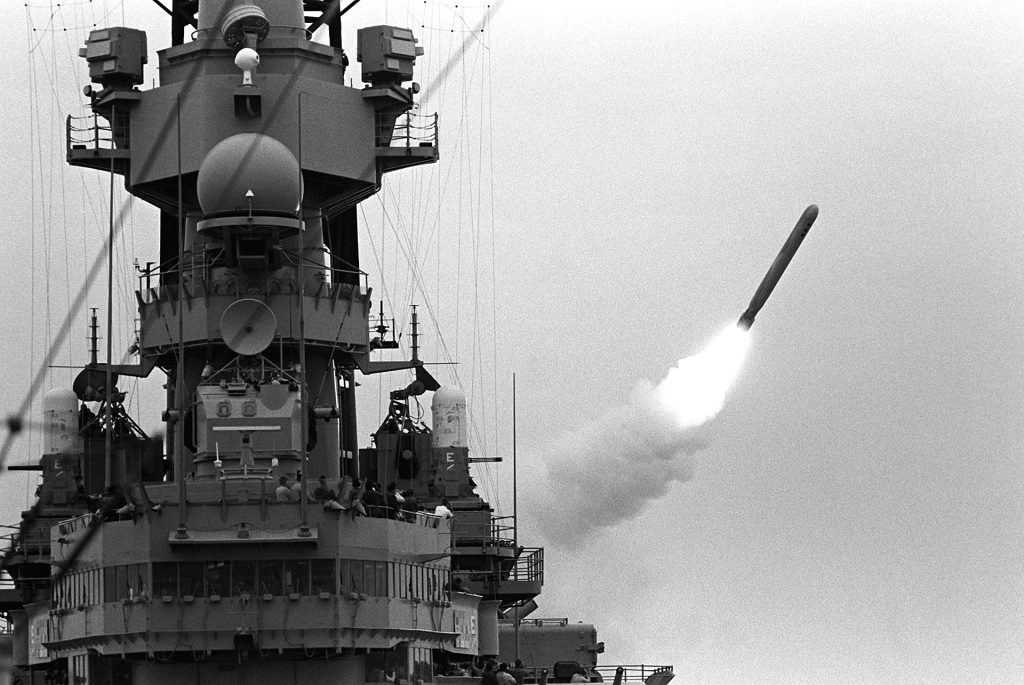The USS Missouri experienced a significant mishap in 1950 when she ran aground near Thimble Shoal Light in the Chesapeake Bay. This incident occurred shortly after her reactivation for the Korean conflict.
Despite this setback, the Missouri was successfully refloated with the aid of multiple tugboats and underwent repairs before returning to active duty.
Contents
Construction of the USS Missouri
The USS Missouri During WWII
The Grounding Incident
The Korean War
The USS Missouri During the Gulf War
Construction of the USS Missouri
The keel of the USS Missouri was laid down at the Brooklyn Navy Yard on January 6, 1941, at a time when the United States was rapidly expanding its naval capabilities in anticipation of possible involvement in World War II. The Missouri was launched on January 29, 1944, amidst much fanfare, as the American public and military officials recognized the strategic importance of such a formidable vessel. She was officially commissioned into the Navy on June 11, 1944, with Captain William M. Callaghan in command.
Read More A US Destroyer Fired a Torpedo at the USS Iowa While the President was on Board
The USS Missouri’s design featured a sleek, elongated hull with a length of 887 feet (270 meters) and a beam (width) of 108 feet (33 meters). This considerable size allowed for extensive armament and armor while maintaining the necessary speed and maneuverability. Her full-load displacement was approximately 58,000 tons, making her one of the largest battleships ever built. The hull’s streamlined design, combined with powerful engines, enabled the Missouri to achieve speeds exceeding 33 knots (38 mph; 61 km/h), making her one of the fastest battleships of her time. This speed was crucial for keeping pace with aircraft carriers and other fast-moving elements of the fleet.
 The launch of the USS Missouri, 29 January 1944.
The launch of the USS Missouri, 29 January 1944.
The Missouri was armed with an array of weapons designed to engage both surface and aerial threats. Her primary armament consisted of nine 16-inch (406 mm) Mark 7 naval guns, arranged in three turrets, each capable of firing 2,700-pound (1,200 kg) armor-piercing shells over 20 miles (32 km). These guns were among the most powerful ever mounted on a battleship, capable of penetrating the armor of enemy ships and providing devastating shore bombardment support.
In addition to her main battery, the Missouri was equipped with twenty 5-inch (127 mm) /38 caliber dual-purpose guns mounted in ten twin turrets. These guns served both anti-ship and anti-aircraft roles, providing versatile firepower against a variety of threats. To enhance her air defense capabilities, the Missouri also carried an array of smaller caliber anti-aircraft weapons, including 40 mm Bofors and 20 mm Oerlikon cannons. These weapons created a dense protective screen against enemy aircraft, which was particularly important given the increasing threat from kamikaze attacks later in the war.
 Image taken on the ship’s deck taken during her commissioning ceremonies, 11 June 1944.
Image taken on the ship’s deck taken during her commissioning ceremonies, 11 June 1944.
The USS Missouri was heavily armored to withstand significant damage in battle. Her belt armor, which protected the sides of the ship, was up to 12.1 inches (307 mm) thick, providing substantial resistance against enemy shells and torpedoes. The deck armor, designed to protect against plunging fire from high-angle shells and bombs, ranged from 7.5 inches (190 mm) to 9.5 inches (241 mm) in thickness. Critical areas such as the gun turrets, conning tower, and magazines were given additional armor protection to ensure the ship could continue fighting even under heavy attack.
Read More Temper, Temper – That Time the USS Wisconsin Wasn’t Messing Around
She was powered by eight Babcock & Wilcox boilers connected to four geared steam turbines, which drove four propellers. This system generated a total of 212,000 shaft horsepower (158,000 kW), enabling the battleship to achieve her impressive top speed. The ship’s range was equally notable, with a maximum cruising range of 15,000 nautical miles (28,000 km) at 15 knots (17 mph; 28 km/h), allowing her to operate effectively across vast ocean distances without frequent refueling.
The USS Missouri During WWII
Upon completion of her shakedown cruise and initial training exercises in the Atlantic, the Missouri was assigned to the Pacific Fleet. She departed Norfolk, Virginia, in November 1944, transiting through the Panama Canal to join the war effort against Japan. This move marked the beginning of her crucial role in the final stages of World War II.
 Tugs help to move the vessel as she gets underway for her shakedown cruise.
Tugs help to move the vessel as she gets underway for her shakedown cruise.
The USS Missouri’s first significant combat operation was the Battle of Iwo Jima, a major amphibious assault by the United States Marine Corps aimed at capturing the strategically important island. Arriving off Iwo Jima in February 1945, the Missouri provided extensive naval gunfire support. Her 16-inch guns shelled Japanese fortifications, bunkers, and artillery positions, softening up the defenses ahead of the Marine landings. The precise and devastating bombardment by the Missouri and other supporting ships was instrumental in reducing Japanese resistance, enabling the Marines to establish beachheads and ultimately secure the island.
Following her success at Iwo Jima, the USS Missouri was deployed to support the invasion of Okinawa, the largest amphibious assault in the Pacific Theater. Arriving in March 1945, the Missouri once again used her formidable firepower to bombard Japanese positions on the island. Her primary and secondary batteries played a critical role in neutralizing enemy defenses, including artillery emplacements, troop concentrations, and infrastructure. The bombardment continued for several weeks, providing vital support for the ground forces engaged in the fierce and protracted battle.
Read More 3 Sailors Were Trapped in the West Virginia for 16 Days After the Pearl Harbor Attack
The Okinawa campaign also saw the Missouri face a significant threat from Japanese kamikaze attacks. On April 11, 1945, a kamikaze plane struck the starboard side of the ship, causing a fire but failing to penetrate the armor or cause significant damage. The ship’s efficient damage control teams quickly extinguished the fire and repaired the damage.
 Moments before the USS Missouri was struck by a Kamikaze.
Moments before the USS Missouri was struck by a Kamikaze.
As the war drew to a close, the USS Missouri continued to support operations against Japan. She participated in the bombardment of the Japanese home islands, targeting industrial facilities, military installations, and transportation infrastructure. These bombardments were part of a broader strategy to weaken Japan’s ability to continue the war and to compel its surrender.
The USS Missouri’s most historically significant moment came on September 2, 1945, when she hosted the formal surrender ceremony of Japan in Tokyo Bay. This event marked the official end of World War II and was witnessed by representatives from the Allied Powers and Japanese officials. General Douglas MacArthur, Supreme Commander for the Allied Powers, presided over the ceremony, which took place on the Missouri’s deck. Representatives from Japan, including Foreign Minister Mamoru Shigemitsu and General Yoshijiro Umezu, signed the Instrument of Surrender, formally ending hostilities.
The Grounding Incident
On the morning of January 17, 1950, the USS Missouri (BB-63) prepared to leave the Norfolk Naval Base in Virginia for routine training exercises. Commanded by Captain William D. Brown, the Missouri was expected to navigate through the relatively shallow waters of Chesapeake Bay, a task that, while routine, required careful attention to navigational details.
Read More Japan’s Surrender was Signed on Board the USS Missouri
As the Missouri began its departure, several key factors aligned to create a perfect storm of navigational challenges. Firstly, the weather conditions were far from ideal. Overcast skies and reduced visibility hindered the crew’s ability to rely on visual bearings. Despite having access to modern navigational equipment for the time, including radar and sonar, the crew predominantly depended on visual cues and landmarks, which were obscured by the poor weather.
 The USS Missouri after running aground on the Shoal.
The USS Missouri after running aground on the Shoal.
Secondly, the complexity of the Chesapeake Bay’s waterways added to the difficulty. The bay is known for its shifting sandbars, narrow channels, and varying depths, which can be treacherous even for experienced navigators. The Missouri, with its deep draft and significant size, required precise navigation to avoid running aground in these unpredictable waters.
During the departure, a series of navigational errors occurred. The bridge crew, responsible for plotting the ship’s course and ensuring it stayed within the designated channel, misjudged their position relative to Thimble Shoal Light, a crucial navigational marker. Miscommunication among the officers exacerbated the situation; orders and course corrections were not conveyed clearly or executed promptly, leading to further deviation from the safe channel.
Read More The Turret Explosion on the USS Iowa
As the Missouri continued on its erroneous course, the depth beneath the keel gradually decreased. The ship’s draft, combined with the shallow waters of the bay, meant there was little margin for error. Eventually, the Missouri’s hull made contact with a sandbar, and the battleship came to a halt, firmly grounded.
 The ship’s stern cleared the waterline.
The ship’s stern cleared the waterline.
The immediate aftermath saw a flurry of activity. The ship’s crew attempted to free the Missouri using the ship’s engines, but these efforts proved futile. The incident quickly escalated, drawing attention from naval authorities.
Naval command initiated a comprehensive salvage operation. This involved coordinating multiple tugboats to try and pull the Missouri off the sandbar. Divers were deployed to assess the damage and to help position pontoons and other flotation devices to aid in the refloating process. Dredging operations were also conducted to deepen the water around the ship, creating a viable path for its extraction.
Read More The USS Minneapolis Had a Bow Made From Coconut Trees
The salvage operation lasted over two weeks, during which the Missouri remained stranded. Fortunately, the battleship sustained only minor structural damage, mainly to its hull, which was repaired relatively quickly once the ship was freed.
 Tugs attempting to free the Missouri on 21 January, 1950.
Tugs attempting to free the Missouri on 21 January, 1950.
In the aftermath, the Navy conducted a thorough investigation. The findings pointed to human error as the primary cause. Captain William D. Brown was held accountable for the incident, facing a court-martial that resulted in his removal from command.
The Korean War
The USS Missouri arrived off the coast of Korea in September 1950, joining the U.N. forces fighting against the North Korean invasion of South Korea. Her role in the Korean War was primarily focused on providing naval gunfire support for ground troops and bombarding enemy positions along the Korean Peninsula.
Read More Fort Funston had 16-inch Battleship Guns
One of her first significant actions was during the defense of the Pusan Perimeter, a critical phase of the Korean War where U.N. forces were besieged by North Korean troops. The Missouri’s 16-inch guns delivered devastating firepower against North Korean artillery and troop concentrations, helping to stabilize the front lines and prevent a complete collapse of U.N. defenses.
 USS Missouri firing a salvo from her number 2 turret on targets in Korea, 1951.
USS Missouri firing a salvo from her number 2 turret on targets in Korea, 1951.
The Missouri also played a vital role in the successful amphibious assault at Inchon in September 1950, a daring operation planned by General Douglas MacArthur. The battleship’s heavy bombardment softened enemy defenses, clearing the way for the U.N. forces to land and recapture Seoul. This operation was a turning point in the Korean War, allowing U.N. forces to regain the initiative and push North Korean troops back across the 38th parallel.
After the Korean War, the Missouri continued to serve in various capacities, including training exercises and goodwill visits. However, with the advent of newer naval technologies and changing military strategies, the era of battleships was gradually coming to an end. The Missouri was decommissioned again in 1955, marking the end of her active combat service.
The USS Missouri During the Gulf War
In the early 1980s, the geopolitical landscape once again underscored the need for a strong naval presence, prompting the U.S. Navy to modernize and reactivate the USS Missouri as part of President Ronald Reagan’s 600-ship Navy program. This initiative aimed to project American naval power globally and ensure maritime dominance during the Cold War. The modernization of the Missouri transformed her from a World War II-era battleship into a formidable platform equipped with the latest in naval warfare technology.
Read More S-130 – The Last Remaining German E-Boat
The modernization process, undertaken at the Long Beach Naval Shipyard, involved extensive upgrades to the ship’s weaponry, electronics, and overall capabilities. The most significant enhancement was the addition of missile systems. The Missouri was outfitted with Tomahawk cruise missiles, which provided long-range, all-weather strike capabilities, enabling her to hit land targets with pinpoint accuracy from hundreds of miles away. The ship was equipped with Armored Box Launchers (ABL) that could hold 32 Tomahawk missiles. Additionally, Harpoon anti-ship missiles were installed to enhance her capability to engage enemy vessels at long ranges, further expanding her combat versatility.
 Firing a Tomahawk Missile from the USS Missouri during Operation Desert Storm.
Firing a Tomahawk Missile from the USS Missouri during Operation Desert Storm.
For improved defense against incoming missiles and aircraft, the Missouri was fitted with four Phalanx CIWS (Close-In Weapon Systems). These rapid-fire, radar-guided gun systems could detect and destroy threats at close range, significantly enhancing the ship’s defensive capabilities. The modernization included upgrades to the ship’s radar and electronic warfare systems, improving the Missouri’s ability to detect and track enemy targets, as well as to counter electronic threats. Advanced command and control systems were also installed to facilitate better communication and coordination with other naval and air units, ensuring the Missouri could operate effectively in a modern naval task force.
To further increase her versatility, a flight deck was added to accommodate helicopters. This addition allowed the Missouri to conduct reconnaissance, search and rescue, and logistical support operations, thereby extending her operational reach and flexibility. These comprehensive upgrades transformed the Missouri into a hybrid vessel, blending the heavy artillery of a traditional battleship with the precision strike capabilities of a missile cruiser.
Gulf War Service
The USS Missouri’s modernization was put to the test during Operation Desert Storm in 1991, a conflict that underscored her strategic value in contemporary naval warfare. In January 1991, the USS Missouri was deployed to the Persian Gulf as part of a coalition force assembled to liberate Kuwait from Iraqi occupation.
Read More That Time the USS Wisconsin Collided With a Destroyer
During Operation Desert Storm, the Missouri launched her first Tomahawk missiles against Iraqi targets on January 17, 1991. These strikes were part of a larger campaign to degrade Iraq’s command and control infrastructure, air defenses, and communication networks. The Missouri’s 16-inch guns were also used to bombard Iraqi coastal defenses and artillery positions. Her firepower was instrumental in neutralizing enemy fortifications and providing support for coalition ground forces.
 USS Missouri in her current state as a museum ship. Image by Stan Shebs CC BY-SA 3.0
USS Missouri in her current state as a museum ship. Image by Stan Shebs CC BY-SA 3.0
Following her service in the Gulf War, the USS Missouri continued to operate until her final decommissioning on March 31, 1992. She was struck from the Naval Vessel Register in 1995 and subsequently donated to the USS Missouri Memorial Association in 1998, now serving as a museum ship at Pearl Harbor, Hawaii.